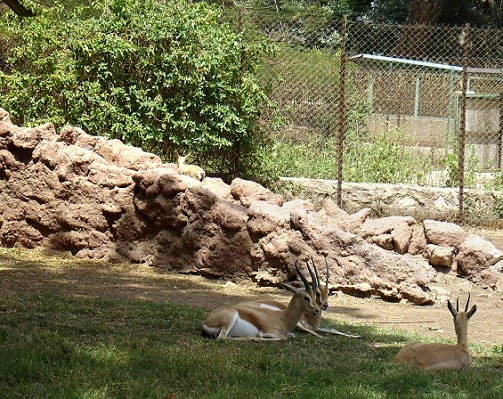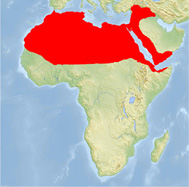|
|
|
|
|
|
|
|
|
|
Dorcas Gazelle غزال مصري
|

|
|
Dorcas Gazelle at Giza Zoo
Class: Mammalia
Order: Artiodactyla
Family: Bovidae
Species: Gazella dorcas |
Distribution:
Dorcas Gazelle is found in the northern Ethiopian biogeographic region and the southwestern Palearctic region. These gazelles inhabit parts of northern Africa, and the Sahara and Negev deserts including Morocco, Rio de Oro, Algeria, Tunisia, Libya, Chad, Somalia, Ethiopia and parts of Palestine and Sinai in the Middle East. |  |
Habitat:
Dorcas Gazelle is the best equipped member of the genus Gazella to inhabit dry areas. They are found in a variety of habitats savannahs, semi-deserts, small sand dune fields, consolidated dune areas, and wadis, and are associated with a number of different plant species.
Description:
Dorcas Gazelle varies in coloration, depending on the location. They are generally pale colored and have a white underbelly with two brown stripes on either side. The head is darker than the rest of the body.
Their horns have the most pronounced curve of members of Gazella . Horns of males are 40 cm long and have 20-24 rings. Female's horns are smaller and straighter with 16-18 rings. Adult males average 25 kg, while the females are about 12 kg, although average size varies among populations. They are the second smallest gazelle species.
Lifespan:
In captivity Dorcas Gazelle can live up to 15 years. Average lifespan in the wild is unknown and may vary by population.
Diet:
Dorcas gazelle individuals feed on the flowers, leaves, and pods of Acacia trees in many of the areas they inhabit. They also feed on fruits and leaves of a variety of bushes.
Behavior:
Dorcas Gazelle is highly adapted to the desert. They can go their entire lives without drinking, as they can get all of the moisture they need from the plants in their diet, though they do drink when water is available. They are able to withstand high temperatures, but when it is very hot they are active mainly at dawn, dusk and during the night. Dorcas Gazelles are able to run at speeds of up to 80 km per hour.
Depending on local climate, a group of G. dorcas will consist of one or two males with a harem of females or just a male-female pair. In extreme climates, where resources are scarce, they primarily associate in pairs.  | New Born Dorcas Gazelle at Giza Zoo
| Reproduction:
During September to November mating season males will guard territory marked by their droppings.
In the wild, females will usually begin reproducing around age 2 years. In captivity pregnancy can happen as early as six months of age. About 90% of females in the wild became pregnant. They give birth to only one offspring per pregnancy in almost all cases. Pregnancy lasts around 6 months and the fawn is born with hair and open eyes. Young spend the majority of their first 2 weeks curled up in the shade. |
Afterwards they will follow the mother around looking for solid food. Males do not seem to participate in the care of the young, except indirectly through resource defense for the group.Conservation Status:
IUCN Red List: Vulnerable This species is considered threatened and in the past was classified as vulnerable by the IUCN. The ongoing threats to this species are habitat destruction and illegal hunting.
|
|
|
|
|
|
|
|
|
|